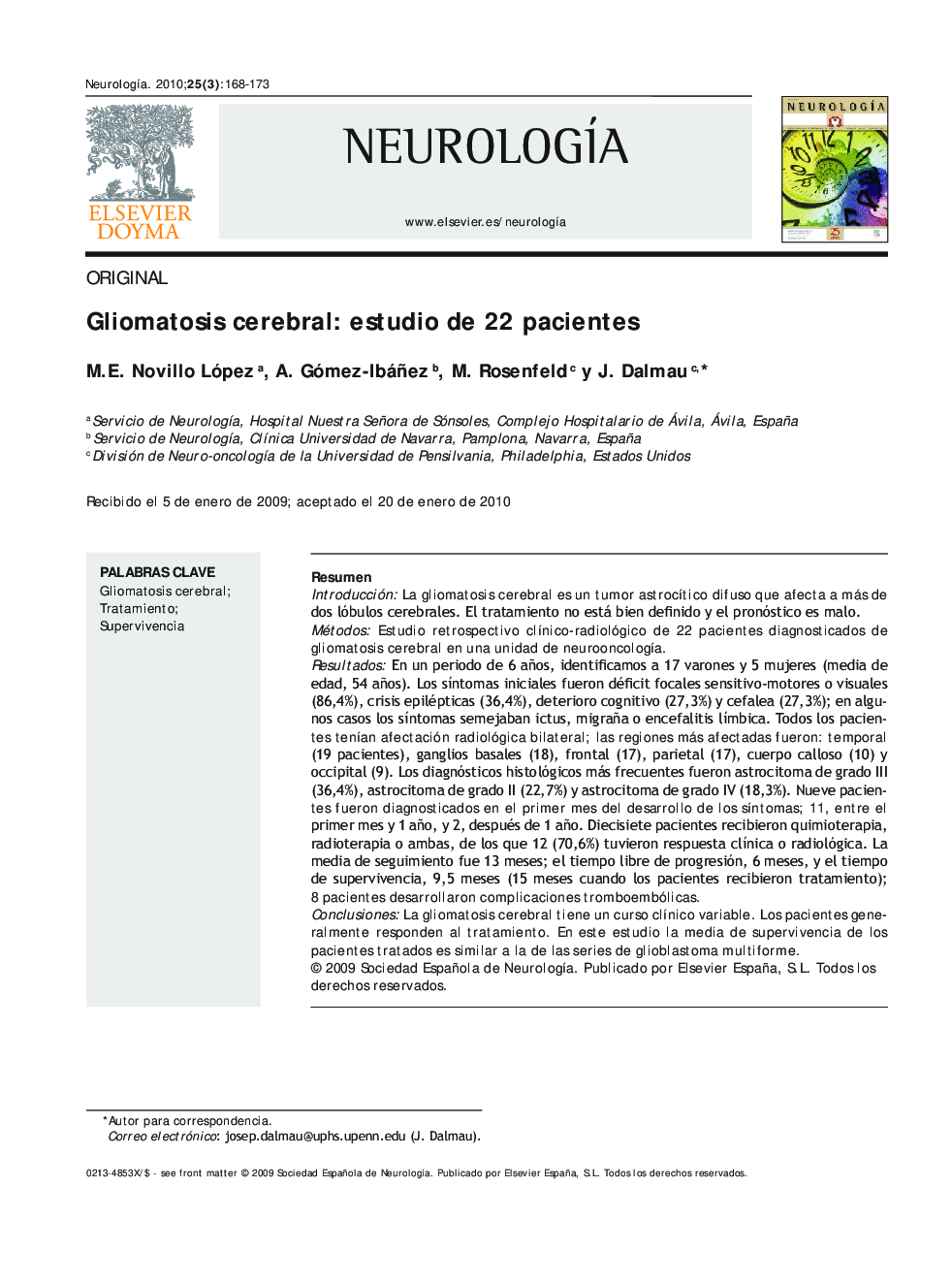| Article ID | Journal | Published Year | Pages | File Type |
|---|---|---|---|---|
| 3076224 | Neurología | 2010 | 6 Pages |
ResumenIntroducciónLa gliomatosis cerebral es un tumor astrocítico difuso que afecta a más de dos lóbulos cerebrales. El tratamiento no está bien definido y el pronóstico es malo.MétodosEstudio retrospectivo clínico-radiológico de 22 pacientes diagnosticados de gliomatosis cerebral en una unidad de neurooncología.ResultadosEn un periodo de 6 años, identificamos a 17 varones y 5 mujeres (media de edad, 54 años). Los síntomas iniciales fueron déficit focales sensitivo-motores o visuales (86,4%), crisis epilépticas (36,4%), deterioro cognitivo (27,3%) y cefalea (27,3%); en algunos casos los síntomas semejaban ictus, migraña o encefalitis límbica. Todos los pacientes tenían afectación radiológica bilateral; las regiones más afectadas fueron: temporal (19 pacientes), ganglios basales (18), frontal (17), parietal (17), cuerpo calloso (10) y occipital (9). Los diagnósticos histológicos más frecuentes fueron astrocitoma de grado III (36,4%), astrocitoma de grado II (22,7%) y astrocitoma de grado IV (18,3%). Nueve pacientes fueron diagnosticados en el primer mes del desarrollo de los síntomas; 11, entre el primer mes y 1 año, y 2, después de 1 año. Diecisiete pacientes recibieron quimioterapia, radioterapia o ambas, de los que 12 (70,6%) tuvieron respuesta clínica o radiológica. La media de seguimiento fue 13 meses; el tiempo libre de progresión, 6 meses, y el tiempo de supervivencia, 9,5 meses (15 meses cuando los pacientes recibieron tratamiento); 8 pacientes desarrollaron complicaciones tromboembólicas.ConclusionesLa gliomatosis cerebral tiene un curso clínico variable. Los pacientes generalmente responden al tratamiento. En este estudio la media de supervivencia de los pacientes tratados es similar a la de las series de glioblastoma multiforme.
IntroductionGliomatosis cerebri is a diffuse astrocytic neoplasm that involves more than two lobes of the brain. Treatment is not well defined and the prognosis is considered poor.MethodsRetrospective analysis of 22 patients with gliomatosis cerebri.ResultsWe identified 17 men and 5 women (median age 54 years) seen in a Division of Neuro-oncology over a 6 year period. Patients presented with focal sensorimotor or visual deficits (86.4%), seizures (36.4%), cognitive dysfunction (27.3%), or headache (27.3%), suggesting in some cases stroke, migraine, or limbic encephalitis. All patients had bilateral involvement; the regions involved included, temporal (19), basal ganglia (18), frontal (17), parietal (17), corpus callosum (10), and occipital (9). The most frequent pathological findings were grade III astrocytoma (36.4%), grade II astrocytoma (22.7%), and grade IV astrocytoma (18.3%). Nine patients were diagnosed within the first month of symptom development, 11 between the first month and 1 year, and 2 after one year. Seventeen patients received treatment with chemotherapy, radiotherapy or both, and 12 patients (70.6%) had a clinical or radiological response. The median follow-up was 13 months, median progression free survival 6 months, and median survival 9,5 months (15 months if the patients received treatment). Eight patients had thromboembolic events.ConclusionsGliomatosis cerebri has a variable clinical course. Treatment often results in clinical responses. In this study de median survival of patients who received treatment was similar to that reported in series of glioblastoma multiforme.
